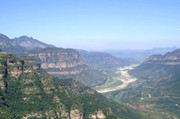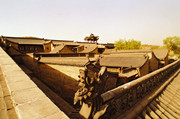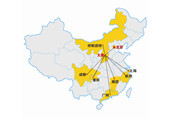Taosi site
( www.chinadaily.com.cn )
Updated: 2012-03-12
The Taosi temple site is a relic under national protection that typifies the Longshan Culture along the middle reaches of the Yellow River.
It contains the ruins of the Miaodigou culture, and some remains of the Warring States Period (475-221 BC), Han Dynasty (206 BC-AD 220), Jin Dynasty (265-420), and Yuan Dynasty (1271-1368). It lies to the south of the village of Taosi, in Xiangfen county, Shanxi, on three million square meters of gound.
Archaeologists say that the Longshan culture gave the Taosi Temple its charateristics. According to carbon dating, the Taosi culture dates back to 2,500 - 1,900 BC. More than 70 sites have been found along the lower reaches of Fenhe and Huihe rivers in southwestern Shanxi. The temple site has been valuable in discovering the origins of Chinese classics, the Chinese nation, and the Xia Dynasty culture (c. 21st century - 16th century BC).
There are many small house traces on the temple site, surrounded by roads, wells, pottery kilns and ash pits. The houses come in three types: aboveground, semi-cave, and cave dwellings, with the latter two being more common. The foundations of the semi-cave dwellings are mostly square with rounded corners, about two to three meters square.
The interior floor was packed or baked straw-based mud, largely coated with a layer of lime, which also can be seen in the paintings on the walls, showing the widespread use of lime in those days. The center of the dwellings had pole holes and a kitchen pit and the walls usually contained big or small niches.
Some dwellings had cooking benches on one side of the room, connected with a chimney to the outside. The cave-dwelling walls narrowed upwards in an arc to form a vault about two meters high. The wells were round, about 13 meters high and the bottom had a wood structure to protect them. There were pottery kilns built into horizontal caves, about half a meter to one meter in diameter, with a number of parallel or leaf vein-style flame paths. The ash pits had a barrel shape and pan bottom. There were also rammed earth fragments and lime wall coverings with geometrical patterns, showing large architecture sites nearby.




